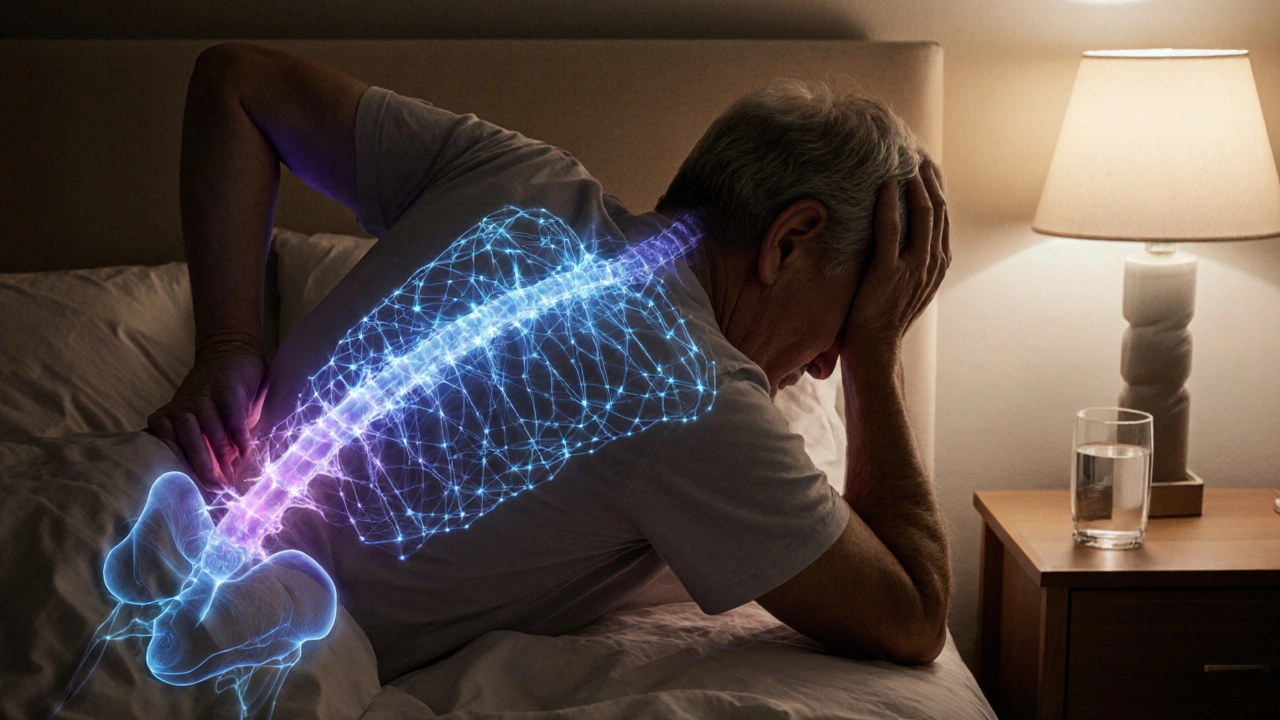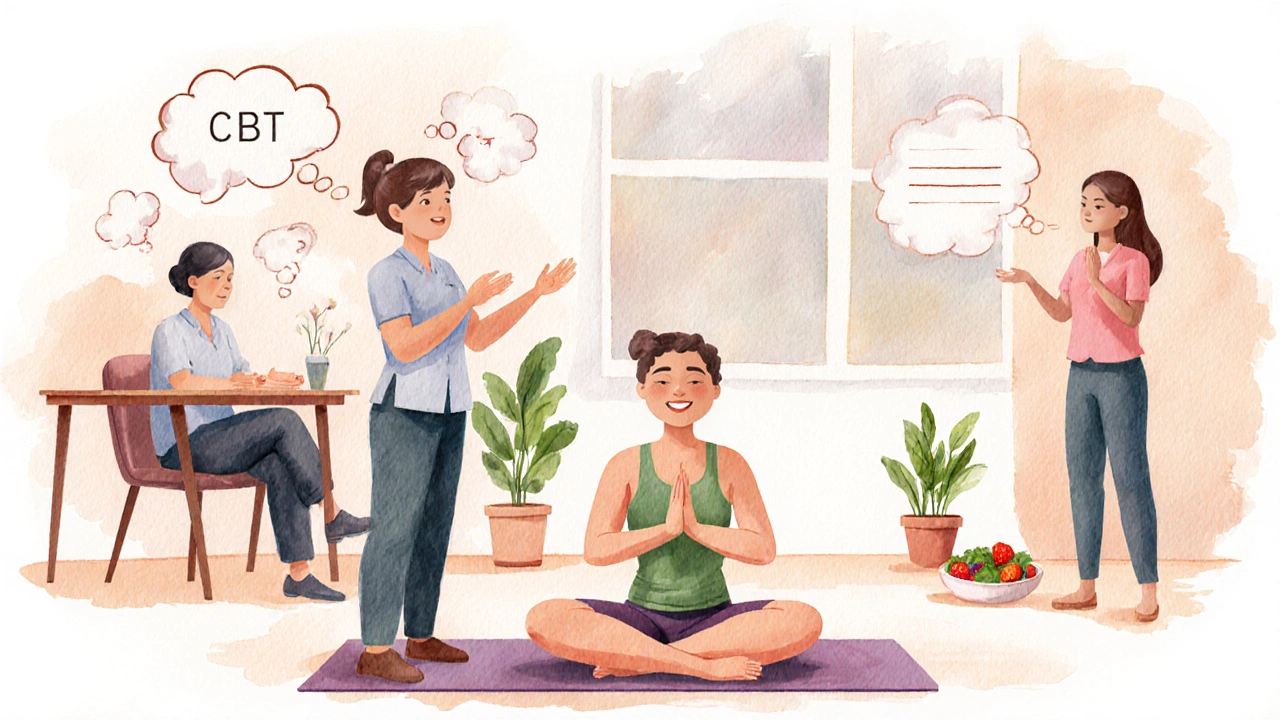 Oct, 25 2025
Oct, 25 2025
Imagine waking up every morning with a dull, relentless ache that refuses to quit-even after you’ve tried a handful of pills, stretches, and doctor visits. That’s the reality for millions living with Chronic pain is a pain condition persisting longer than three months, often outlasting normal tissue healing. The big question on everyone’s mind is: can you truly overcome it, or are you stuck with a lifetime of discomfort?
What Exactly Is Chronic Pain?
Chronic pain isn’t just a longer version of an acute injury. It’s a complex brain‑body response that can arise from nerve damage, ongoing inflammation, or even without a clear physical cause. When the nervous system stays “on alert,” it rewires itself-a process called central sensitization. This means the brain starts treating harmless signals as painful, so the sensation becomes its own disease.
Why Does It Stick Around?
Three main mechanisms keep chronic pain alive:
- Neuroplastic changes: The pain pathways become hyper‑excitable, making the signal louder.
- Inflammatory loops: Ongoing low‑grade inflammation keeps the peripheral nerves primed.
- Psychological factors: Fear, anxiety, and catastrophizing amplify the perceived intensity.
Understanding these drivers is the first step toward breaking the cycle.
Mindset Shift: Pain Neuroscience Education
Before diving into treatments, many experts recommend Pain neuroscience education is a brief, evidence‑based program that explains how the nervous system creates pain. By learning that pain isn’t always a sign of tissue damage, patients often report reduced fear and lower pain scores. It’s a cheap, zero‑side‑effect tool that prepares the brain for the next steps.

Core Pillars of a Successful Approach
Research consistently shows that a combination of therapies works far better than any single method. Below are the most reliable pillars.
1. Physical Activity & Exercise
Regular, graded movement re‑educates the nervous system. Whether it’s walking, swimming, or low‑impact strength work, activity boosts endorphins, improves circulation, and reduces inflammation. Start with just 10 minutes a day and gradually increase intensity. The key is consistency, not intensity.
2. Physical therapy is a hands‑on treatment that uses movement, manual techniques, and education to restore function
Therapists design personalized exercise plans, teach proper posture, and address muscular imbalances that may fuel pain. Studies show up to 30% pain reduction in chronic low‑back sufferers after 12 weeks of supervised PT.
3. Cognitive Behavioral Therapy (CBT)
CBT tackles the psychological side by reshaping negative thoughts and coping strategies. A typical program runs 8‑12 weekly sessions, teaching skills like thought‑recording, relaxation, and activity pacing. Patients who combine CBT with physical rehab often see the biggest gains.
4. Mindfulness & Meditation
Mindfulness meditation is a mental practice that cultivates non‑judgmental awareness of present‑moment sensations. Regular practice (10‑20 minutes daily) reduces the emotional amplification of pain, lowers cortisol, and can even change brain regions associated with pain perception.
5. Sleep Hygiene
Poor sleep fuels inflammation and worsens central sensitization. Aim for 7‑9 hours, keep the bedroom dark, and avoid screens an hour before bedtime. If insomnia persists, a brief course of CBT‑I (insomnia) may be warranted.
6. Nutrition & Anti‑Inflammatory Diet
Foods rich in omega‑3 fatty acids, antioxidants, and low in refined sugars can blunt inflammatory pathways. Consider adding fatty fish, berries, leafy greens, and nuts while cutting back on processed snacks.
7. Pharmacologic Options (Non‑Opioid First)
When meds are needed, clinicians typically start with the safest options:
- Acetaminophen is a pain reliever with minimal anti‑inflammatory effect, suitable for mild to moderate pain.
- Non‑steroidal anti‑inflammatory drugs (NSAIDs) such as ibuprofen or naproxen reduce inflammation and are effective for many musculoskeletal pains.
- Gabapentin is a neuropathic pain medication that modulates calcium channels in the nervous system, often used for nerve‑related pain.
- When oral meds fall short, topical agents (capsaicin, lidocaine patches) provide localized relief with fewer systemic effects.
Reserving opioids for short‑term rescue only, and under strict monitoring, is the current best practice.
8. Interventional Procedures
For pain that doesn’t respond to conservative care, clinicians may turn to:
- Nerve blocks are injections that temporarily interrupt pain signals, offering both diagnostic insight and relief.
- Spinal cord stimulation is a mini‑device that delivers low‑level electrical currents to dampen pain transmission, often used for failed‑back‑surgery syndrome.
- Radiofrequency ablation uses heat to deactivate specific nerves, providing months‑long relief for certain joint pains.
9. Interdisciplinary Pain Programs
Interdisciplinary pain program is a team‑based approach that blends medical, physical, and psychological therapies under one roof. These programs typically run 6‑12 weeks, offering daily PT, CBT, nutrition counseling, and medication review. Outcomes show up to 50% reduction in pain intensity and significant functional gains.
How the Options Stack Up
| Treatment | Typical Effectiveness | Invasiveness | Average Cost (US$) | Duration Needed |
|---|---|---|---|---|
| Exercise & PT | Moderate‑to‑high | Low | 500‑2,000 | 8‑12 weeks |
| CBT | Moderate | Low | 300‑1,200 | 8‑12 sessions |
| Mindfulness | Low‑to‑moderate | Low | Free‑200 (apps) | Daily practice |
| Gabapentin | Moderate (neuropathic) | Low | 30‑100 per month | Ongoing |
| Spinal Cord Stimulation | High (selected cases) | High (surgery) | 30,000‑50,000 | Implant + follow‑up |
| Interdisciplinary Program | High | Low‑to‑moderate | 2,000‑6,000 | 6‑12 weeks |
Building Your Personal Roadmap
Here’s a step‑by‑step guide you can adapt right now:
- Schedule a comprehensive assessment with a pain specialist who emphasizes chronic pain treatment that isn’t solely medication‑driven.
- Start a daily movement habit-10 minutes of gentle walking or stretching, and track how your pain changes.
- Enroll in a pain neuroscience education session (many clinics offer a free 1‑hour workshop).
- If anxiety or catastrophizing is high, book a CBT therapist who works with chronic pain patients.
- Add a 10‑minute mindfulness practice each morning; use free apps like Insight Timer.
- Review your sleep environment. Aim for a consistent bedtime routine; consider a short CBT‑I course if needed.
- Discuss medication options with your doctor, focusing on non‑opioid agents first.
- If progress stalls after 8‑12 weeks, ask about interventional options or an interdisciplinary program.
Common Pitfalls to Avoid
- All‑or‑nothing thinking: Expecting a miracle cure leads to disappointment. Progress is gradual.
- Relying on a single therapy: Pain is multifactorial; a combo works best.
- Ignoring mental health: Mood disorders amplify pain signals. Treat them alongside the physical aspects.
- Over‑medicating: High‑dose opioids can increase sensitivity over time.
- Skipping follow‑ups: Regular check‑ins let you tweak the plan before setbacks become entrenched.
Real‑World Success Stories
Emma, a 42‑year‑old office manager, lived with fibromyalgia for six years. After joining an interdisciplinary program that mixed PT, CBT, and a Mediterranean diet, her average pain dropped from 7/10 to 3/10, and she returned to yoga after a decade.
Mark, a former truck driver with chronic low‑back pain, started a 15‑minute daily walk plus weekly PT. Within three months, his reliance on NSAIDs fell by 80%, and his doctor tapered him off the medication entirely.
Next Steps
If you’re ready to take charge, start with the first two items on the roadmap today. Remember, chronic pain doesn’t have to own your life-consistent, multi‑modal effort can shift the balance in your favor.
Can chronic pain ever disappear completely?
Complete disappearance is rare, but many people achieve a level of control where pain no longer limits daily activities. Success hinges on combining physical, psychological, and lifestyle strategies.
Is exercise safe for someone with severe pain?
Yes, when the activity is graded and supervised. Starting with low‑impact moves reduces the risk of flare‑ups and actually helps calm the nervous system.
Do I need medication if I follow a non‑pharmacologic plan?
Many patients can taper off opioids and even NSAIDs when physical and mental therapies are in place. Medication decisions should be personalized with your doctor.
What is the role of mindfulness in pain reduction?
Mindfulness trains the brain to observe pain without judgment, which lowers the emotional amplification that makes pain feel worse. Regular practice can cut perceived intensity by 20‑30%.
How long does an interdisciplinary program usually last?
Most programs run 6‑12 weeks, with daily sessions that blend PT, CBT, nutrition, and medication review. Longer follow‑up often continues on a monthly basis.
